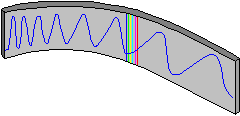![]() Alcohol
Protecting Group
Alcohol
Protecting Group ![]()

Group Members
Alvarez, David
[email protected]Fuchs, Tarra
[email protected]Kirchhoefer, Pat
[email protected]
Group Meetings:
The Alcohol Protecting Group met several times over the period of this assignment to prepare this project. We discussed the project for 15 minutes after each class period during the weeks since the project was assigned. In addition to this we met eithe r in the reading room or someone's office for approximately 1 hour each week to go over details concerning information obtained in our individual searches. Finally in the week before the project was due we met several times for 1 to 2 hours per session to write drafts and revisions of the paper. As a group we have met a total of approximately 9 hours and individually we have worked between 4-7 hours each researching companies and instruments.
Enzyme Kinetics Determination by UV/VIS Spectroscopy

The purpose of our group is to set up the spectroscopy lab for the research and development unit of a new chemical company. The overall goal is to find an instrument that is best suited for the task at hand but will also be versatile enough to be us ed by other departments of the company. Our specific task is to find an instrument appropriate for the study of enzyme kinetics that is routinely performed by the research and development unit. The activity of an enzyme is the rate at which the enzyme rea cts with the substrate to form a product. This activity is determined by measuring the absorbance of the product produced or the loss of absorbance as the substrate is used up. By measuring absorbance at different time intervals and plotting amount of abs orbance versus time, the rate of reaction and the overall kinetics of the enzyme can be determined. An example of this is the reaction of aldolase enzyme with a sugar.
D-fructose-1,6-bisphosphate æ æ adolaseæ ® dihydroxyacetonephosphate(DHAP)
alpha-glycerophosphate + NAD+
¨ æ dehydrogenaseæ æ 3 phospho-D-glyceraldehyde + NADH + H + DHAP
The increase and decrease of absorbance in enzyme kinetics mechanisms commonly appear in the ultraviolet to visible region of the frequency spectrum, therefore the use of a UV/VIS spectrometer is the logical choice of an instrument to best suit our nee ds. Typical wavelengths, which are commonly monitored in enzyme kinetics, fall between 240 and 436 nm, which is within the range of common UV/VIS spectrometers. Absorbance readings obtained can be manually manipulated into kinetics information or can be a utomatically handled by special software designed to handle kinetics calculations. Most modern UV/VIS spectrometers can be connected to computers with special software. These computer programs have advanced functions that easily convert absorbance and con centration data to kinetic information. Another option available with modern UV/VIS spectrometers is a temperature controlled multicell transport. This is a necessity for enzyme kinetics experiments as these reaction rates are very temperature and time de pendent. The multicell transport allows cells of solution to be analyzed at specific intervals while keeping the temperature constant.
To begin our search of UV/VIS instruments, we first went to the Analytical Chemistry ë97-í98 LabGuide (http://pubs.acs.org). From the list of UV/VIS suppliers, we identified companies that are reasonabl y well known and searched their World Wide Web sites for information on their product lines. Companies that were investigated include:
Once some initial decisions concerning specific instruments were made from the web pages, more detailed information was requested via the mail to help streamline our search. Upon looking at various UV/VIS spectrometers from these companies, w e decided the middle-to-top of the line equipment would best suit our needs. It was commonly found with most companies that their top of the line units often had extras that were not needed for our purpose. Many of these instruments were also designed for a specific purpose that was not applicable to enzyme kinetics studies. Assuming no other areas of our company required these extra features, it would be a waste of money to buy the top of the line instrument.
The two spectrometers we narrowed our search down to were the Hewlett-Packard 8453 and the Beckman DU7500. Both of these spectrometers are bench-top diode array instruments with connections for multicell transports and computer control. The technical issues that we deemed most important in comparing UV/ VIS instruments were the wavelength range, wavelength accuracy/reproducibility, and scan speed. Specifications of these issues for each instrument is listed below:
|
HP 8453 |
Beckman DU7500 |
|
|
wavelength range |
190-1100 nm |
190-800 nm |
|
wavelength accuracy (reproducibility) |
+/- 0.5 nm (+/-0.04nm) |
+/- 1.25 nm (+/-0.05nm) |
|
scan speed |
0.1 seconds |
0.1 seconds |
We looked at wavelength to see how these instruments compare if we were using them to measure absorbances at the far end of the range. We were concerned with the accuracy/reproducibility to reduce instrumental error in our experiment and to satisfy quality control requirements. Scan speed is important as the absorbance changes as a function of time for enzyme experiments therefore rapid determination is essential.
Quotes were obtained from both companies to determine our overall costs. Our team was not constrained by a budget, but we were well aware that saving money looks just as good to the top executives as does having a good instrument. A detailed bre akdown of the quotes obtained is listed below:
HP 8453
|
Biochemical UV/VIS system (Includes spectrophotometer, multicell transport, general & biochemical software, Vectra Pentium PC, 24 MB RAM, 15" monitor, Win 95, HP DeskJet printer) |
$16,200.00 |
|
Product Installation and Familiarization |
$607.50 |
|
Rectangular Quartz Cell 10mm, 3mL |
$103.50 |
|
Total |
$17,532.00 |
Beckman DU 7500
|
Step-programmable spectrometer, monitor |
$12,600.00 |
|
Installation |
$700.00 |
|
Accessory Option board |
$430.00 |
|
Temperature Controller |
$1,470.00 |
|
Kinetics Plus Software |
$1,280.00 |
|
Peltier temperature control auto cell holder |
$2,050.00 |
|
Total |
$17,530.00 |
After reviewing our research we have concluded that we will purchase the HP 8453 spectrometer. The difference in price for comparable systems was negligible, therefore the main deciding factors were the extended wavelength range, higher degre e of wavelength reproducibility, and inclusion of a computer system in the system price. Both instruments are from well-respected companies that have a reputation for quality and good service. Each company offered comparable warranties and service contrac ts. The HP8453 is "user-friendly" in the aspect of minor maintenance with replaceable parts (for example the lamps can easily be changed by access through a side door). The addition of the computer system with the biochemical software was an added plus fo r the HP system. The biochemical software allows the use of predefined methods as well as user-defined methods for time-based measurements using multiple samples. The software also automatically analyzes the data and evaluates the rate type as well as man y other functions. Of interest to other parts of our company, general use software is included which again has many predefined methods and functions for most applications.
![]()
Group Dynamics:
Working as a group on this project had its share of positive and negative attributes. This would have been a project that could have easily been done by just one person except that we would have run out of spectroscopic instruments. It was helpf ul to have other people when collecting information from companies. Also each person brought in individual knowledge and experiences that helped to avoid personal bias from influencing the decision. The hardest part of working in the group was in writing the final paper. Even though everyone had equal input as to the content, the final version could easily, if even unintentionally, reflect the view to the person writing it. The collaborative learning process seemed to stay focused on the project at hand. As a group we benefited in getting to know each other a little better than we would have from just sitting in class together. Although we are undecided on whether or not future group activities would be good based on the above argument.

![]()
This web page was brought to you by the:
alcohol protecting group
